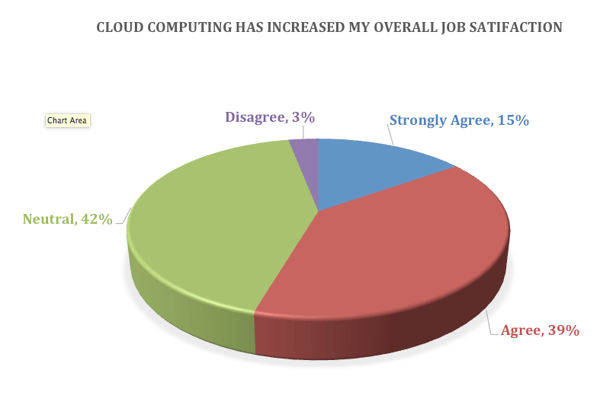Published on
Increased IT Staff Satisfaction an Undervalued Benefit of the Cloud

Beginning in 2007 Georgia Southern University initiated an aggressive strategy to move legacy systems into the cloud and adopt a “Cloud First” approach to selecting new information systems. Cloud computing allowed the institution to rapidly adopt and deploy best-fit solutions, effectively manage risk, maximize availability, drive new efficiencies, leverage data, develop new business models and embrace mobility in ways that would not have been possible with the traditional approach and available resources.
A cloud-first strategy shifts the IT budgeting approach from uncertain periodic infusions of year-end capital to planned annual operational expenses. It also prompts strong partnerships between the IT services and functional area stakeholders, shifting the emphasis from technology implementation to business/education projects. An unexpected benefit of a cloud computing strategy is the potential for a profoundly positive impact on IT staff.
Cloud computing represents a fundamental change to traditional IT strategy on many levels. While the potential functional and financial impacts of cloud computing are often illuminated in both research and popular publications, the benefits of cloud computing on job satisfaction and retention of IT staff are less prevalent. It is reasonable to infer that technological changes in response to cloud computing initiatives could easily lead to decreases in perceived job satisfaction among IT staff due to requisite job modifications. In an environment of technological change, CIOs are well advised to be cautious of impacts of imposed job modifications on IT staff.[1] This is particularly prudent in light of the fact that nearly one-fifth of higher education IT professionals are at high risk for leaving their current positions.[2]
It is well established that a cloud computing strategy requires a different set of IT skills.[3], [4] The implementation of cloud computing involves transitioning job descriptions and the re-alignment of the IT organization from back-office operations to customer-facing strategy services such as programmers to business analysts and system/database administrators to application managers.
The transition may also require modifying job descriptions and reorganizing staff. “Cloud First” eventually led to fewer—but higher paying—positions. It also created new promotion opportunities for IT staff. The transitioning of staff did not happen by CIO edict or a precise plan, nor were they implemented all at once. Rather, the strategy is played out through incremental organizational change, through training of existing staff and exposing them to new opportunities, and through natural events such as retirements, resignations and promotions.
To counteract these planned job modifications, training and organizational support are critical to sustaining IT staff job satisfaction.[5] A “Cloud First” strategy required staff to acquire new business and technical acumen, project management, and process mapping skills. Training on soft skills—such as effective conflict resolution, decision making methods, teambuilding practices and good listening and communication skills—are valuable at all levels of the IT organization and in particular among management and business analysts.
Successfully transitioning staff to roles and skills that facilitate the adoption of cloud-based systems, platforms and infrastructure opens the door for fundamental changes in IT organization. IT staff move closer to the lines of the institution’s business, providing services that enable functional offices to gain the maximum value from their technology investments.
While some people readily and enthusiastically embraced the change and personal challenge, these transformative changes aren’t for everyone. Leaders of cloud computing initiatives must not only be committed to the technology but also committed to the most valuable resource in cloud initiatives: the IT staff. Following Jim Collin’s, Good to Great metaphor, it is leadership’s responsibility to find a seat—the right seat—for everyone who’s on the IT services bus. After all, not every application in use is cloud based and, amazingly enough, some of us still have Common Business Oriented Language (COBOL), a relic of programming language, in the code of critical production legacy systems.
IT staff who experienced the transition to cloud computing overwhelmingly indicated that supporting cloud computing versus traditional systems increased their overall job satisfaction. Transition to the cloud relieves staff of the mundane work of systems management, reduces burnout, and increases personal time with family and friends leading to greater job satisfaction and an improved quality of life.
IT staff experience greater satisfaction from solving business/education problems and seeing the impact of their work first-hand. For many staff, cloud responsibilities are more rewarding than late nights and long weekends of monitoring system backups, patching systems, upgrading hardware and trouble-shooting with an overly defensive vendor tech support desk. Instead, the drudgery of caring for computers and storage arrays gives way to the creation of productive and rewarding relationships among team members who strive to achieve shared goals and outcomes. In the cloud computing environment, IT staff are agile and engaged with functional offices exploring new approaches and leveraging functional capabilities of cloud systems to better serve institutional strategy and the interests of students, faculty and staff.
The cloud-based collaboration tools adopted as part of a “Cloud First” initiative provide the opportunity for IT and functional office staff to work remotely and with more autonomy. This is particularly important to staff with family circumstances that might otherwise prevent them from coming to work that day. The use of collaboration tools also reinforces the virtues of cloud computing while facilitating efficient and effective work and a quality of life that bolsters job satisfaction and retention.
Another positive impact of cloud computing on IT staff job satisfaction is recognition. Simple recognition of a job well done is particularly meaningful when obtained from those benefited by your work. Computer center staff who work on campus-hosted systems often only hear from users when systems don’t operate as planned. On the contrary, IT staff who make the transition to supporting cloud services are more likely to be recognized frequently for their achievements in solving problems. These recognitions have a powerful impact on staff and contribute significantly to their job satisfaction and retention.[6]
To summarize, cloud computing simplifies the definition of success for IT service organizations through the realignment of resources and restatement of staff roles to directly engage stakeholders and leverage technology for those things that matter most to CIOs and presidents—outcomes that advance our institution’s strategic agenda. A hidden benefit to transitioning to cloud computing is increased job satisfaction among IT workers, which leads to increased employee retention.
The retention of high-value IT staff with both technical and soft skills is critical for a sustained competitive advantage and higher education CIO’s have repeatedly placed IT talent management at the top of their issues lists. From a leadership point of view, it’s also very rewarding to see people highly motivated, engaged, appreciated, rewarded and excited about their work. In this context I think about 1950’s management theorist Frederick Herzberg who said, “If you want someone to do a good job, give them a good job to do.” Cloud computing has proven to be a very good job.
– – – –
References
[1] Burrell, S. (2014). IT staff turnover intentions, job modification, and the effects of work recognition at large public higher education institutions”. Electronic Theses & Dissertations. Georgia Southern University. Available at http://digitalcommons.georgiasouthern.edu/etd/1099
[2] Bichsel, J. (2014). Today’s Higher Education IT Workforce (p. 45). EDUCAUSE Center for Analysis and Research. Louisville, CO. Available at http://www.educause.edu/ecar
[3] Bailey, J. L. (2014). Non-technical skills for success in a technical world. International Journal of Business and Social Science, 5(4). Available at http://ijbssnet.com/journals/Vol_5_No_4_Special_Issue_March_2014/1.pdf
[4] Cummings, J., Janicki, T., and Kline, D. (2014). Shifting Technological Landscape: IT Departments and Anticipated Technological Changes. Journal of Information Systems Applied Research, 7(4). Available from http://edsigbh.org/org.jisar/2014-7/N4/JISARv7n4.pdf#page=38.
[5] Burrell, 2014
[6] Ibid
Author Perspective: Administrator




